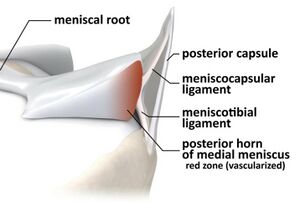Coronary Ligaments of the Knee: Difference between revisions
Chloe Waller (talk | contribs) (Updated description) |
Chloe Waller (talk | contribs) (Updated clinical relevance) |
||
| Line 13: | Line 13: | ||
== Clinical relevance == | == Clinical relevance == | ||
Coronary ligament injuries can lead to other knee joint pathology and negatively alter the biomechanics of the knee<ref name=":1">Smith PA, Humpherys JL, Stannard JP, Cook JL. [https://pubmed.ncbi.nlm.nih.gov/31914474/ Impact of Medial Meniscotibial Ligament Disruption Compared to Peripheral Medial Meniscal Tear on Knee Biomechanics]. J Knee Surg. 2021 Jun;34(7):784-792</ref>. Lesions to the coronary ligaments can increase rotational instability<ref name=":0">A. Peltier, T. Lording, L. Maubisson, R. Ballis, P. Neyret, S. Lustig. [https://pubmed.ncbi.nlm.nih.gov/26264383/ The role of the meniscotibial ligament in posteromedial rotational knee stability] Knee Surg Sports Traumatol Arthrosc 2015 23:2967–2973</ref>. Moreover, an injury to these ligaments can lead to increased strain on the [[Anterior Cruciate Ligament|anterior cruciate ligament]] or menisci, increasing the risk of injury to these structures<ref>Krych AJ, Bernard CD, Leland DP, Camp CL, Johnson AC, Finnoff JT, Stuart MJ. [https://pubmed.ncbi.nlm.nih.gov/31332493/ Isolated meniscus extrusion associated with meniscotibial ligament abnormality.] Knee Surg Sports Traumatol Arthrosc. 2020 Nov;28(11):3599-3605.</ref><ref>Smith PA, Humpherys JL, Stannard JP, Cook JL. [https://pubmed.ncbi.nlm.nih.gov/31914474/ Impact of Medial Meniscotibial Ligament Disruption Compared to Peripheral Medial Meniscal Tear on Knee Biomechanics.] J Knee Surg. 2021 Jun;34(7):784-792.</ref> . Research suggests coronary ligament injuries are under diagnosed and therefore can go untreated<ref name=":1" />. | |||
== Assessment == | == Assessment == | ||
Depending on the severity of the injury, patients presenting with a coronary ligament injury will typically experience pain that is frequently sharp with sudden movements and may or may not be accompanied by swelling. Most of the time, the patient is still able to walk, and both flexion and extension ranges of motion are complete, but with discomfort at end range. A severe injury may result in an effusion that limits full end ranges. | Depending on the severity of the injury, patients presenting with a coronary ligament injury will typically experience pain that is frequently sharp with sudden movements and may or may not be accompanied by swelling. Most of the time, the patient is still able to walk, and both flexion and extension ranges of motion are complete, but with discomfort at end range. A severe injury may result in an effusion that limits full end ranges. | ||
Revision as of 08:48, 22 November 2022
This article is currently under review and may not be up to date. Please come back soon to see the finished work! (29 May 2024)
Original Editor -Simisola Ajeyalemi andRewan Elsayed Elkanafany
Top Contributors - Chloe Waller, Simisola Ajeyalemi, Rewan Elsayed Elkanafany, Kim Jackson and Tien Yunn How
Description[edit | edit source]
The coronary ligaments, also known as the meniscotibial ligaments, are part of the fibrous capsule of the knee joint. They are made up of the medial coronary ligament and the lateral coronary ligament. They connect the inferior edges of the menisci to the of the tibial plateau[1].
Function[edit | edit source]
The coronary ligaments support rotational stability of the knee and prevent anterior tibial translation[2].
Clinical relevance[edit | edit source]
Coronary ligament injuries can lead to other knee joint pathology and negatively alter the biomechanics of the knee[3]. Lesions to the coronary ligaments can increase rotational instability[4]. Moreover, an injury to these ligaments can lead to increased strain on the anterior cruciate ligament or menisci, increasing the risk of injury to these structures[5][6] . Research suggests coronary ligament injuries are under diagnosed and therefore can go untreated[3].
Assessment[edit | edit source]
Depending on the severity of the injury, patients presenting with a coronary ligament injury will typically experience pain that is frequently sharp with sudden movements and may or may not be accompanied by swelling. Most of the time, the patient is still able to walk, and both flexion and extension ranges of motion are complete, but with discomfort at end range. A severe injury may result in an effusion that limits full end ranges.
A thorough history of the injury and physical examination are using adequate in diagnosing an injury but if the their is still doubt an MRI can confirm the diagnosis.
A useful test to assess a coronary ligament injury is the McMurray test
Treatment[edit | edit source]
Treatment will vary according to the injury, its degree and whether any other structures have been affected as well .
References[edit | edit source]
- ↑ Guy S, Ferreira A, Carrozzo A, Delaloye JR, Cavaignac E, Vieira TD, Sonnery-Cottet B. Isolated Meniscotibial Ligament Rupture: The Medial Meniscus "Belt Lesion". Arthrosc Tech. 2022 Jan 13;11(2):e133-e138.
- ↑ Feger J, Knipe H, Knipe H, et al. Meniscotibial ligaments. Available from: https://radiopaedia.org/articles/meniscotibial-ligaments(Accessed on 21 Nov 2022)
- ↑ 3.0 3.1 Smith PA, Humpherys JL, Stannard JP, Cook JL. Impact of Medial Meniscotibial Ligament Disruption Compared to Peripheral Medial Meniscal Tear on Knee Biomechanics. J Knee Surg. 2021 Jun;34(7):784-792
- ↑ A. Peltier, T. Lording, L. Maubisson, R. Ballis, P. Neyret, S. Lustig. The role of the meniscotibial ligament in posteromedial rotational knee stability Knee Surg Sports Traumatol Arthrosc 2015 23:2967–2973
- ↑ Krych AJ, Bernard CD, Leland DP, Camp CL, Johnson AC, Finnoff JT, Stuart MJ. Isolated meniscus extrusion associated with meniscotibial ligament abnormality. Knee Surg Sports Traumatol Arthrosc. 2020 Nov;28(11):3599-3605.
- ↑ Smith PA, Humpherys JL, Stannard JP, Cook JL. Impact of Medial Meniscotibial Ligament Disruption Compared to Peripheral Medial Meniscal Tear on Knee Biomechanics. J Knee Surg. 2021 Jun;34(7):784-792.
- ↑ Advanced Massage Techniques School.Knee Coronary Ligaments TestAvailable from https://www.youtube.com/watch?v=zMQl73Mw-rM







